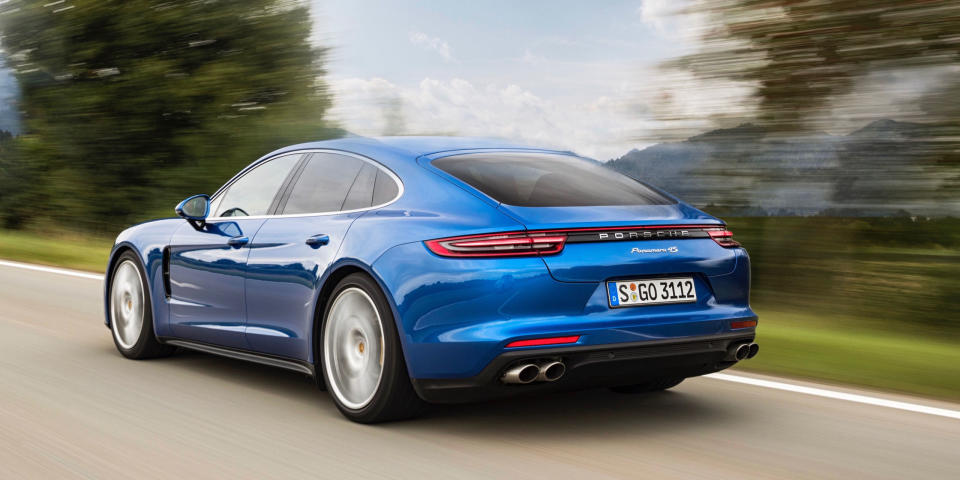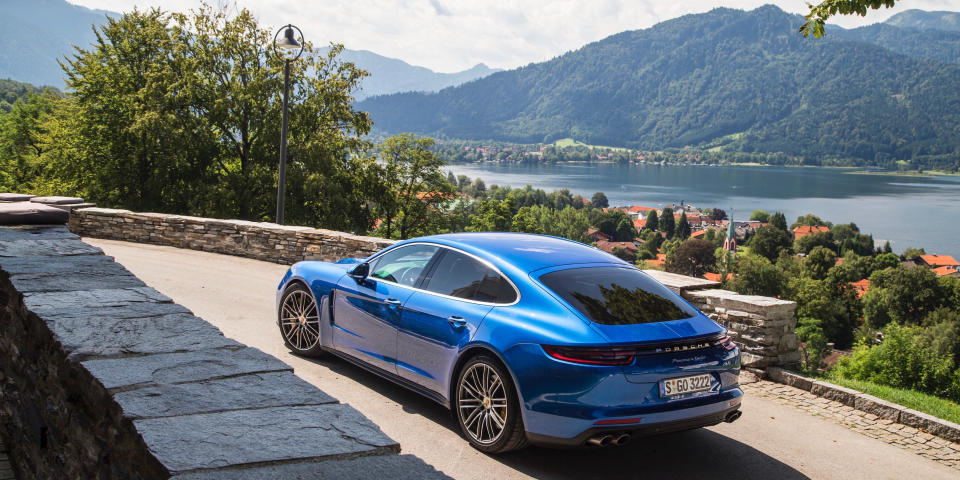First Drive: 2017 Porsche Panamera 4S and Panamera Turbo

The original Panamera has been described many ways. Graceless. Tortured. Uglier than an inside-out monkey. Really, the car was just a product of its time. Porsche's longtime CEO Wendelin Wiedeking, an overly ambitious, awkwardly tall man, wanted a 911 sedan he could sit inside. So he built one. Then the bottom fell out, the boardroom got Machiavellian, Wiedeking was ousted, and Porsche succumbed to Volkswagen Group takeover. The whole saga stunk of reality television. The Panamera was an ugly cry.
Things seem better now. Product is steady, sales figures are cushy. Porsche is back racing, and winning, at Le Mans in a top-flight prototype. The Panamera, all-new for this year, reflects that stability. This second-generation design looks confident, sleeker, and more cohesive. The greenhouse and roofline finally cooperate, smoothed into one continuous fastback arc, complemented by the face-lifted 911's corporate LED jewelry. The shape still isn't for everybody, but at least the strained hunchback jokes are behind us. (Good riddance.)
Inside, the cavernous four-bucket layout carries over, replete with soft leathers and piano trim. Also screens. Many screens. Two in the gauge cluster alone, which, save for a traditional rev counter, is now entirely digital. Gone is the the old button-bonanza shifter galley, replaced by a glassy wall of touch-sensitive icons replaces. Requisite me-too gadgetry includes a thermal night-vision camera, cabin ionizer, seat massagers, and semiautonomous cruise control. The optional 20-speaker audio setup, a 1455-watt job from Burmester, is a bowel-shaking must.


The changes are more than skin-deep. This is the new MSB chassis, an aluminum and steel that's scalable to four wheelbases across Volkswagen Group brands. At first blush, the platform sharing looks like a proprietary loss. Engineers say it's not. Apparently, Porsche and Audi clashed over materials and dimensions during development; Audi tried to take control of the project, only to be shut down by Volkswagen Group brass. So expect beanballs at the company softball game, and the next A8 to use a different chassis, mostly out of spite. MSB, meanwhile, is entirely of Porsche's own design.
The resulting sedan is initially in two flavors, 4S and Turbo. The former uses a 440-hp, 2.9-liter V-6, a lopped-off version of the latter's 550-hp, 4.0-liter V-8. Both are direct-injected and twin-turbocharged, snails situated inside a 90-degree valley. The transmission, also new, is a dual-clutch eight-speed sourced from ZF but tuned by Porsche in house. Shift times match those of the 911 GT3. This gearbox is designed to handle 738 lb-ft of torque and accept an electric motor, so brace yourself for a hybrid variant. Also a long-wheelbase variant, shooting brake variant, rear-drive S variant, sportier GTS variant, and high-output Turbo S variant. There is no manual. Only Europe gets a diesel.
We do, however, get launch control. Launch control. Engage Sport Plus mode, stand on the brake, then depress the throttle. Boost builds and the chassis tenses, tachometer chain-gunning away at 5000 rpm. Loading up the Turbo feels like harnessing a dying star, two tons of potential energy on the brink of spectacular. Lifting off the brake is that sort of event, a supernova of induction noise and raw power. Peripheral vision collapses; space-time gets fuzzy. Somewhere, a BMW M6 Gran Coupe owner weeps. Porsche's people quote 0-to-60-mph times of 3.6 seconds, or 3.4 with the Sport Chrono package. We should all be so modest.

Like the Turbo, the 4S is all-wheel drive. The system, in either application, shrugs off repeated back-to-back launches and does kinky stuff in the corners. Push hard through a hairpin or fast sweeper, and you feel the driveline shuffling, shouldering supercar g-loads. The Panamera can route 100 percent torque to either axle, but is rear-biased by default. Tire widths are staggered accordingly, and the sheer mechanical grip is astonishing. If there's understeer, you're probably on a racetrack or driving it wrong.
Predictably, the eight-cylinder car hits hard on the top end, and gets frisky with big throttle lifts or heavy deceleration. The balance-shaft-equipped six is a pleasant surprise, mixing a more usable torque curve with fantastic noises, all inside a machine that's lighter on its feet. Both cars ride beautifully in Comfort mode, okay in Sport, and like oversized, well-upholstered Shake Weights in Sport Plus. The standard brakes (six-piston front calipers, vented iron rotors) seem unkillable. Carbon ceramics, a $8960 option, should carry some kind of warning label for pregnant women.
Porsche is close to cracking the electric power steering code, and the Panamera reflects that progress. The talkative rack is one of the more transparent parts here; the spec sheet reads as a stock-ticker of algorithmic excess. There's PASM (continuously variable damping, three-chamber adjustable air suspension optional), PTV (electronic locking rear differential, active torque vectoring), PDCC (electromechanical roll bars), and, all irony being lost on the Germans, HAL (rear-axle steering). There are so many chassis systems, Porsche had to create a new system to manage them all. Information from each sensor is now funneled into a separate data suite, whose sole job is sorting and analyzing that data, then parsing it out.

"The original Panamera contained 2 million lines of code," says Gernot Döllner, the sedan's project boss. "This one contains over 100 million."
He then relayed this bombshell: Roughly 500 first-gen cars came off the assembly line with a manual gearbox. More than 300 of those were ordered by people within the company.
These two anecdotes are not unrelated. Seven years ago, Porsche built a sedan for its eccentric CEO and a niche buyer that didn't yet exist. With time, the alien weirdness of that car has dissipated, and the objectives have become less subversive. (Döllner makes no mention of the original four-door 911 pretense, allowing only that Stuttgart now understands luxury-sedan customers. He also mentions focus groups, because of course he does.)
In terms of outright performance, the Panamera remains a singular proposition. It may not be the brand's most involving drive, but the hubris-meets-competence ethos reeks of Porsche, with bells and whistles to boot. As a feat of engineering, and now a focused luxury product, it's a triumph.
Porsche Panamera Turbo
Price: $147,950
Powertrain: 4.0-liter twin-turbo V8, 550 hp, 568 lb-ft; AWD 8-speed automatic
Weight: 4400 lb
0-60 mph: 3.6 sec
Top speed: 190 mph
On sale: now
You Might Also Like

 Yahoo Autos
Yahoo Autos 